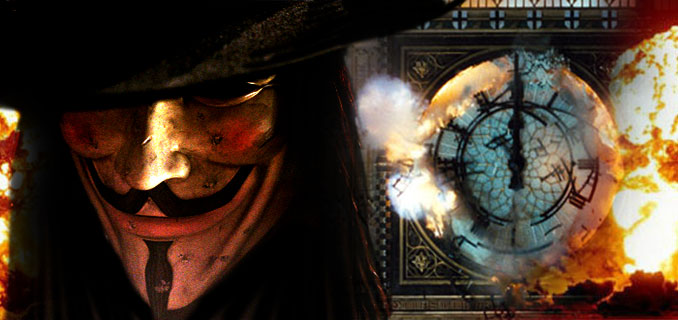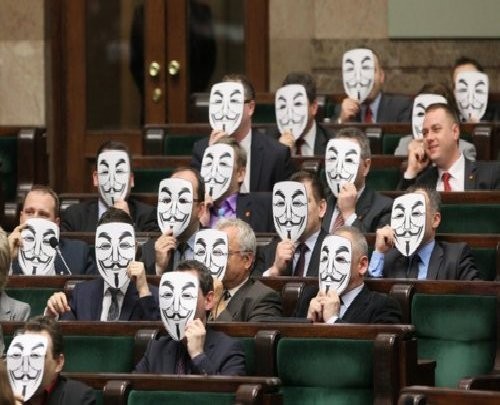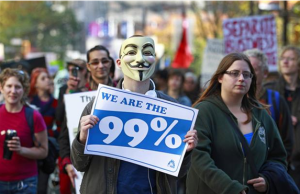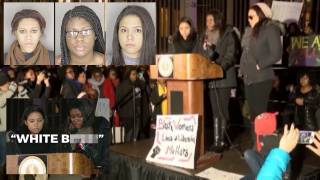Guy Fawkes, the Gunpowder Plot, and how false flag operations have shaped history
Source: truthandshadows.wordpress.com
Remember, remember, the 5th of November,Gunpowder, treason and plot.
I see no reason why the gunpowder treason
Should ever be forgot.
-Old English folk rhyme (anonymous)

By Barrie Zwicker (Special to Truth and Shadows)
Today, November 5th, is Guy Fawkes Day, also known as Gunpowder Day. In 2012 it’s the 407th anniversary of The Gunpowder Plot or Gunpowder Treason, as it was first called.
It also happens to be my 78th birthday. So I’ve been more aware of Guy Fawkes Day than most. I’m especially happy about how ubiquitous the Guy Fawkes mask has become.

[RIC: Members of Poland’s Parliament hold up Guy Fawkes masks, symbolizing protests by Anonymous, to protest ACTA.]
The mask was hugely popularized in the movie V for Vendetta. As stalwart 9/11Truther Kevin Barrett wrote, a year ago, in a piece entitled “Unmasking Media Lies: Why BBC’s V-for-Vendetta Mask Piece is Fawked Up”:
“V for Vendetta may be the most revolutionary film ever made. Its obvious message is: Let’s get out there and visit some rough justice on the treasonous bastards who created the 9/11 and 7/7 media spectaculars, and destroyed the freedoms for which we’ve been fighting for centuries.
It is also possible to read the film from an interior, psychological perspective: Rather than just a call to action, it’s about the psychological process of coming to terms with the 9/11 and 7/7 inside jobs, by allowing oneself to feel the overwhelming anger that is the natural response. Once one has faced the facts, overcome fear, and come to terms with one’s own righteous anger, THEN it’s time for revolution.
 The real message of the V mask is simple: We know you bastards blew up the Trade Center. We know you’re blowing up the economy. We know you’re lying to us 24/7/365. We know you’re trying to keep us poor and weak and fearful and impotent. Well, guess what? We’re not afraid of you. We’re not afraid to die. And we’re coming to get you.
The real message of the V mask is simple: We know you bastards blew up the Trade Center. We know you’re blowing up the economy. We know you’re lying to us 24/7/365. We know you’re trying to keep us poor and weak and fearful and impotent. Well, guess what? We’re not afraid of you. We’re not afraid to die. And we’re coming to get you.No wonder the BBC is afraid to admit what the V mask really means.”
Yet for the first 71 years of my life I had entirely the wrong idea about the gunpowder plot: what happened, who was really behind it, and its impact on history. An impact that continues to this day. It was in 2005 that I read I read Webster Tarpley’s superb book 9/11 Synthetic Terror: Made in USA right after it came off the press. He introduced me to the historical element.
True, the brazen events of 9/11 and the mind-boggling cover-up that followed opened my eyes to state-executed terror frauds and the power they deliver to the dark forces that order them. But I didn’t know from nuthin’ about the Gunpowder Plot.
Nor at that time did I appreciate that it and 9/11 are but two examples from thousands of false flag operations that have changed history.
False flag ops are the least-recognized, highest-impact category of human deceit. In terms of emotional wallop, even the most brilliant lies perpetrated by the most talented demagogues pale, in comparison to a big false flag op, for the power to manipulate the public. On this anniversary let’s look more closely at this particular false flag op for some lessons. As William Faulkner put it in his Requiem for a Nun: “The past is never dead. It’s not even past.” Then we will touch briefly on one of the most recent false flag ops – a leading edge digital one that perversely misappropriates the Fawkes name.
******
On the Throne of England in 1605 sits James the First, a Protestant, the King who ordered the translation of the Christian Bible that bears his name.
As midnight approaches on November the 4th – the eve of the traditional opening of Parliament – armed agents of the King raid a basement room of the Houses of Parliament. They discover and apprehend one Guy Fawkes. His age, 36, coincides with the number of barrels of gunpowder they find with him. They find a tunnel leading to the room. Fawkes is a known agitator for the rights of English Roman Catholics. In his possession are a pocket watch (a rarity in those days).
Had he succeeded in detonating the gunpowder, the next morning King James and his queen would be mangled bodies, as would all the members of the House of Lords and the House of Commons. Smoking rubble would be all that would remain of the Palace of Westminster complex, including historic Westminster Abbey.
So goes the palace version of the events of the late evening of November the 4th, 1605. The English public is stunned. It’s the equivalent of 9/11. “A cataclysm,” Adam Nicolson describes it in his book God’s Secretaries: The Making of the King James Bible. Upon his arrest, according to the official account, Fawkes admits his purpose was to destroy king and Parliament.
That there was some kind of plot is not in doubt. By November the 8th, on the rack, Fawkes names 12 co-conspirators. Those not killed where they are tracked down are found guilty of treason later in a trial lasting less than a day. They and Fawkes are hanged, drawn and quartered.
The following Sunday, November the 10th, the King James Version of the plot is broadcast from the leading pulpit of the Church of England, that of William Barlow, Bishop of Rochester. Barlow thunders that the enemy, meaning papists, is satanic in its wickedness. The King, their hoped-for victim, on the other hand is, Mr. Nicolson writes, characterized as an unqualifiedly good man . . . virtually a Christ-figure.
Soon all the pulpits of England echo the official account. Between 1606 and 1859 the Fifth is remembered in an annual service of thanksgiving in every Anglican church, writes James Sharpe in Remember, Remember: A Cultural History of Guy Fawkes Day. Until 1959, it was against the law in Britain not to celebrate Guy Fawkes Day. Celebrate, because from the beginning the public was giving thanks that the realm was saved and the treasonous conspirators dispatched. For centuries effigies of Fawkes were burned.
The palace version becomes historical truth for humankind including me – duped again! – for most of our lives.
Mr. Nicolson and others now cast serious doubt on that version. Many anomalies concerning the events have surfaced.
Fawkes was not apprehended in a basement room but rather a ground floor room, one remarkably easily rented by the plotters. There was, accordingly, no tunnel. The authorship of the letter by which the King learned of the plot is murky. It was turned over to the King by the Royal Chancellor, Sir Robert Cecil, the Earl of Salisbury.
Sir Cecil I would characterize as the Dick Cheney of his day. Because plots were common at that time Cecil had an efficient network of spies seeded among Roman Catholic dissidents. He kept tabs on all plots the spies discovered. This one featured a large cast of characters from several cities.
Cecil kept the King in the dark about the plot except for the obscure letter. The gunpowder, it turned out, was of an inferior nature, unlikely to have achieved much result. This was odd, as Fawkes definitely knew a thing or two about gunpowder. He had developed expertise with it while serving with distinction in Spain’s army against Protestant rebels in the Netherlands. It’s conceivable the gunpowder could have been switched by someone; loads of it existed because of all the hostilities. Some handwriting on Fawkes’s confession differed from the rest.
Ignored until recently is a book by Jesuit historian John Gerard, What Was the Gunpowder Plot: The Traditional Story Tested by Original Evidence. Gerard died in 1606 but his book was not published for almost three centuries, in1897, an interesting temporal fact in itself. While it’s true, as Sharpe writes, that accounts of the plot differ as per the biases of the authors, I find Gerard’s account pretty compelling. He writes:
“When we examine into the details supplied to us as to the progress of the affair, we find that much of what the conspirators are said to have done is well-nigh incredible, while it is utterly impossible that if they really acted in the manner described, the public authorities should not have had full knowledge…”
Exactly. The evidence points to a particular kind of false-flag operation. There are many variations. In some (9/11 being the leading example) an outrageous event is carried out by the perpetrators and blamed on the chosen enemy. In others (example, Gulf of Tonkin) nothing happens but a fiction blames the chosen enemy. The Gunpowder Plot is midway: a plot was underway but the precise intentions of the plotters can never be known. The main feature is that, with or without taking a hand in the plot, the Cecil elements manipulated events brilliantly.
Cecil was heavily involved in an influential London group known as “the war party.” It wanted to push James into a confrontation with the Spanish Empire, from which the group’s members hoped, among other things, to extract great personal profit.
The war party considered it politically vital to keep persecuting Roman Catholics. Sir Cecil set out, writes Tarpley, to sway James to adopt his policy by means of terrorism.
It amounts to this: Either Cecil and the war party made the Gunpowder Plot happen or they let it happen –and made sure of a brilliantly timed “exposé.” And if they let it happen they made it happen.
James himself had negotiated peace with Spain the previous year. His other advisors told him there was no chance of a general Catholic uprising and that no foreign Catholic powers were involved in the plot.
The King knew, Sharpe writes, that “the reality of Catholicism in England around 1600 was very different from the image conjured up in government propaganda and contemporary Protestant myth.” Sharpe again: “…even in the face of … persecution it seems that most of England’s Catholics remained loyal to their monarch and wanted nothing more than to be allowed to practice their faith unmolested.” (The parallel with most Muslims living in the UK and Canada today springs to mind.)
For his part, James downplayed the plot. “James and his ministers,” Sharpe writes, “showed more restraint than many modern regimes faced with similar problems.”
Nevertheless, the power of the imagery of what might have happened burned itself into the public’s psyche, and was repeatedly fanned by the Protestant and war promoting establishments.
The outcomes of this ongoing propaganda campaign are incontestable. Tolerance for English Roman Catholics is replaced by a period of terrible bloodletting for them. Numbers are killed. Catholics’ homes are burned. A string of laws is passed restricting their rights and liberties.
The English become “fixated on homeland security,“ Nicolson writes. An inclusive, irenic idea of mutual benefit between Spain and England – trade between the two countries, because of the peace treaty, had been growing –“is replaced in England by a defensive/aggressive complex.” All Catholics, of all shades, never mind their enthusiasm or not for the planned attack, are identified as the enemy.
Most significantly, war with Spain ensues. England’s course is set for a century of wars against the Spanish and Portuguese empires. England for various reasons comes out victorious and on these war victories the British Empire is founded in blood, deception and conquest.
---
There’s no way of knowing whether the British Empire – and all the consequences of its rule from Capetown to Canada to Iraq to its American colonies — would have emerged anyway or in what form or at what pace, but we cansee in retrospect that the Gunpowder Plot was pivotal in what did transpire.
It would be a failure of imagination not to see the parallels with 9/11 and society in our day of blanket war propaganda, teeming with covert agents, ever-encroaching surveillance, ever decreasing civil rights and liberties, and either helpless or conniving leaders.
Let’s look at false flag ops generically. It’s difficult in my opinion to over-estimate their terrible place in history, and their place in making history terrible. Think of the wars and millions of deaths that followed the Gunpowder Plot, the sinking of the Maine in Havana Harbour in 1898 that kick-started the US Empire’s expansion to the Philippines and beyond, the sinking of the Lusitania that brought the USA into World War I, the torching of the German Reichstag that boosted Hitler to power and enabled his bloody grab for world domination, the assassination of John F. Kennedy that yanked U.S. foreign policy onto a warpath, the alleged attacks during LBJ’s presidency the next year by North Vietnamese torpedo boats on U.S. warships in the Gulf of Tonkin — attacks that simply did not take place but that provided the basis for the Tonkin Gulf Resolution, passed 88-2 in the US Senate. That resolution constituted the “legal” basis for escalating the Vietnam War with an eventual death toll of more than 3-million. And 9/11. To name a few.
[...]
Read the full article at: truthandshadows.wordpress.com
Tune into Red Ice Radio:
Holland Vandennieuwenhof - Hour 2 - False Flag Methodology
Peter Dale Scott - Hour 1 - Norway’s Massacre, Breivik & Deep Events
Webster G. Tarpley - 9/11 Synthetic Terror
Kent Daniel Bentkowski - Anatomy Of A False-Flag Terror Attack
James Evan Pilato - The Portland Patsy, Fake Terrorism, TSA & Starwhackers
Webster G. Tarpley - The Venetians






















